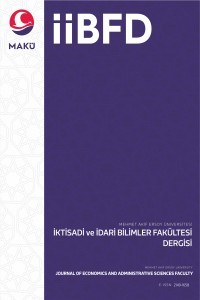NESNELERİN İNTERNETİ DESTEKLİ HTEA VE BULANIK HTEA ANALİZİ İLE MALİYET OPTİMİZASYONU
Hata Türü ve Etkileri Analizi (HTEA), Bulanık HTEA, Üretim, Risk Analizi, Maliyet Optimizasyonu
COST OPTMIZATION WITH INTERNET SUPPORTED FMEA AND FUZZY FMEA ANALYSIS
Failure Mode and Effect Analysis (FMEA), Fuzzy FMEA, Production, Risk Analyses, Cost Optimization,
___
- Besterfield, D.H., Besterfield, C., Besterfield, G., & Besterfield, M. (1999). Total Quality Management (3rd ed.). America, Prentice Hall Publishing.
- Çeber, Y. (2010). Application of failure mode and effects analysis method (FMEA) in manufacturing industry (Master's thesis, Dokuz Eylül University, Izmir). Access address https://acikerisim.deu.edu.tr/xmlui/handle/20.500.12397/10839.
- Çevik, O., and Aran, G. (2009). Failure mode effects analysis (FMEA) in the quality improvement process and an application in piston production. Journal of Social and Economic Research, 8(16), 241-265. Retrieved from https://dergipark.org.tr/tr/pub/susead/issue/28423/302689.
- Çiğdem, M. (2006). Manufacturing methods (2nd edn.). İstanbul, Çağlayan Bookstore Publishing,
- Dağcı, B. (2019). Analysis of error types and effects in the quality improvement process and investigation of errors by data mining: an application in the machining industry. (Unpublished master's thesis). Karabuk University Institute of Science and Technology Industrial Engineering Department, Karabük.
- Filz, M. A., Langner, J. E. B., Hermann, C., and Thiede, S. (2021). Data-driven failure mode and effect analysis (FMEA) to enhance maintenance planning. Computers in Industry, 129, 103451. doi: 10.1016/j.compind.2021.103451.
- Fuzzification and Defuzzification. (t.y.) Difference between fuzzification and defuzzification içinde. 16 Mart 2022 tarihinde https://www.geeksforgeeks.org/difference-between-fuzzification-and-defuzzification/ adresinden erişildi.
- Ghani, A. J., Harron, C. H. C., Hamdan, S. H., Said, A. Y., and Tomadi, A. Y. (2013). Failure mode analysis of carbide cutting tools used for machining titanium alloy. Ceramics International, 39(4), 4449-4456. doi: 10.1016/j.ceramint.2012.11.038.
- Gönen, D. (2004). Failure modes and effects analysis and an application study (Master's thesis, Balıkesir University, Balıkesir). Access address info:eu-repo/semantics/openAccess
- Gül, B. (2001). Failure mode and effects analysis in quality management (Unpublished master's thesis). Gazi University Institute of Science and Technology Industrial Engineering Department, Ankara.
- Güngör, F., & Paçal, K. (2004). The effect of risk analysis in planning of machining system. IV. Proceedings of the National Production Research Symposium. Turkey: Conference publication.
- Güngör, F., & Paçal, K. (2006). The effect of risk analysis on the planning of the machining system. UAS 2006, VI. National Production Research Symposium (1-6 pp). Turkey.
- Huang, G. Q. (2000). Failure mode and effect analysis (FMEA) over the www. The International Journal of Advanced Manufacturing Technology, 16 (8), 603-608.
- Hung, S. W., and Chen, T. K. (2019). Disclosing AlN ceramic substrate process failure mode and effect analysis. Microelectronics Reliability, 103, 113508. doi: 10.1016/j.microrel.2019.113508.
- Kusumadewi, S. (2002). Analisis dan desain sistem fuzzy menggunakan toolbox matlab. Yogyakarta: Graha Ilmu979-3289-02-3 Daftar Pustaka: hlm.
- Li, H., Diaz, H., and Soares, C. G. (2021). A failure analysis of floating offshore wind turbines using AHP-FMEA methodology. Ocean Engineering, 234, 109261. doi: 10.1016/j.oceaneng.2021.109261.
- Lo, H. W., Liou, J. J. H., Haung, C. N., and Chaung, Y. C. (2019). A novel failure mode and effect analysis model for machine tool risk analysis. Reliability Engineering and System Safety, 183, 173-183. doi: 10.1016/j.ress.2018.11.018.
- Mariajayaprakash, A., & Senthilvelan T. (2013). Failure detection and optimization of sugar mill boiler using FMEA and taguchi method. Engineering Failure Analysis, 30, 17-26. doi: 10.1016/j.engfailanal.2012.12.010.
- Mirzaoğlu, İ., and Saritas, M. (2008). Automation of a semolina production system using PLC and SCADA (Master's thesis, Gazi University, Ankara). Access address http://hdl.handle.net/20.500.12602/150129.
- Mzougui, I., and Felsoufi, Z. E. (2019). Proposition of a modified FMEA to improve reliability of product. Procedia CIRP, 84, 1003-1009. doi: 10.1016/j.procir.2019.04.315.
- Sánchez, M., Paz Moral, M., and Ramoscelli, G. (2020). Activity-based costing in smart and connected products production enterprises. Growing Science, 6, 33-50. doi: 10.5267/j.ac.2019.6.002.
- Söylemez, C. (2006). Failure mode and effects analysis occupational safety application. (Unpublished master's thesis). Gazi University, Institute of Science and Technology Industrial Engineering, Ankara.
- Stamatis D. H. (1995). Failure Mode And Effects Analysis – FMEA from Theory To Execution (2nd e.). America, Asq Pr Quality Press Publishing.
- Şen, Z. (2004). Mühendislikte Bulanık (Fuzzy) Mantık ile modelleme prensipleri (Modelling principles with the Fuzzy Logic in engineering). Su Vakfı Publications.
- Ünğan, M. C. (2017). Failure mode effects analysis and an application in automotive parts production. Journal of Business Science (JOBS), 5(2), 217-245. doi: 10.22139/jobs.321887.
- Wang, L.-X. (2008). Adaptive fuzzy systems and control – design and stability analysis.Prentice Hall0130996319.
- Yang, G. (2007). Life cycle reliability engineering. New Jersey: John Wiley &Sons, Inc978-0-471-71529-0.
- Yee T. M., Ahmed, S., and Quader, M. A. (2014, November). Process behaviour and capability analysis for improvement of product quality in car-door glass manufacturing. 5th Brunei International Conference on Engineering and Technology in Brunei. https://www.crossref.org/iPage?doi=10.1049%2Fcp.2014.1059.
- ISSN: 2149-1658
- Yayın Aralığı: Yılda 4 Sayı
- Başlangıç: 2014
- Yayıncı: Burdur Mehmet Akif Ersoy Üniversitesi
İŞ GÜVENCESİZLİĞİ ALGISI VE ÖZ YETERLİLİK DÜZEYİNİN POLİTİK DAVRANIŞ ÜZERİNDEKİ ETKİSİ
Esvet MERT, Sabahat BAYRAK KÖK
BAĞIMSIZ DENETİM KAPSAMINDAKİ SÜREKLİ EĞİTİM PROGRAMLARINA YÖNELİK BİR ARAŞTIRMA
AZERBAYCAN’DA TÜRK MİLLİYETÇİLİĞİNİN OLUŞUM SÜRECİ ÜZERİNE GENEL DEĞERLENDİRMELER
Hakan ALTINTAŞ, Hıfzı TOZ, Ali TAGHIYEV
KARİYER SÜRDÜRÜLEBİLİRLİĞİ ÖLÇEĞİNİN TÜRKÇEYE UYARLANMASI
SAĞLIK ALANINDA YEŞİL MUHASEBE İLE İLGİLİ YAPILAN ÇALIŞMALARIN BİBLİYOMETRİK HARİTALAMASI
Seyhan ÇİL KOÇYİĞİT, İlknur ARSLAN ÇİLHOROZ, Gülşen ÇELİK, Ezgi ÖRS GÜNENÇ
COVID-19 SÜRECİNDE ÜNİVERSİTE ÖĞRENCİLERİNİN UZAKTAN EĞİTİM EĞİLİMİNİN ARAŞTIRILMASI
BİR KOBİ'NİN BANKA SEÇİM SÜRECİNDE ARALIK TİP 2 BULANIK AHP YÖNTEMİ UYGULAMASI
Ufuk AYDOĞMUŞ, Hacer YUMURTACI AYDOĞMUŞ, Davut KARAMAN, Ali YILDIZ, Melih CAN
Ömer Lütfi ANTALYALI, Pınar GÖKTAŞ
İNFORMEL İLETİŞİMİN İŞ BECERİKLİLİĞİ ÜZERİNE ETKİSİNDE İYİMSERLİĞİN ARACILIK ROLÜ
